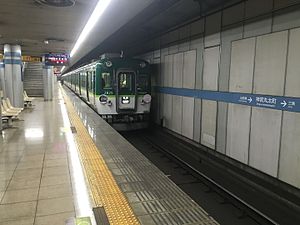Keihan Ōtō Line
This article needs additional citations for verification. (September 2018) |
| Keihan Ōtō Line | |
|---|---|
 Keihan 2600 series EMU at Jingū-Marutamachi Station | |
| Overview | |
| Native name | 京阪鴨東線 |
| Owner | Keihan Electric Railway |
| Locale | Kyoto |
| Termini | |
| Stations | 3 |
| History | |
| Opened | 5 October 1989 |
| Technical | |
| Line length | 2.3 km (1.4 mi) |
| Track gauge | 1,435 mm (4 ft 8+1⁄2 in) |
| Electrification | 1,500 V DC, overhead catenary |
| Operating speed | 90 km/h (55 mph) |
The Ōtō Line (鴨東線, Ōtō-sen) is a railway line in Kyoto that was opened on October 5, 1989 by the Keihan Electric Railway. The Ōtō Line re-established a rail connection between the Keihan Main Line and the Eizan Electric Railway, which had been severed when the Kyoto City streetcars ceased running in 1978. The line is operated as an extension of the Keihan Main Line. All trains continue into the Keihan Main Line and Keihan Nakanoshima Line serving office districts surrounding Nakanoshima in Osaka.
Overview
The route name is derived the line's route on the east shore of Kamo River. It is constructed under Kawabata Street along the Kamo River as an underground extension of the Keihan Main Line. The line is only 2.3 km long but serves as a important transport corridor in central Kyoto.
Addition fares
To recover the cost of construction and interest payments (69 billion yen) of the line, a surcharge of 60 yen is added on top of regular fares when a trip uses the line. The recovery rate at the end of FY2016 was 31.8%; most of it recovered by the 60 yen surcharge. It is undecided whether the additional surcharge will be imposed indefinitely.[1]
History
August 29, 1924: Kyoto Electric Light (predecessor of the Keifuku Electric Railway) acquired a license for laying local railways between Demachiyanagi and Sanjo.
April 10, 1950: Keihan Electric Railway established the Ōtō Line Construction Preparation Committee.
July 1, 1972: Kamogawa Electric Railway was established.
February 20, 1974: Provincial railway laying licence between the Keifuku Electric Railway
February 25, 1974: Kamogawa Electric Railway acquires a license for laying a local railway between Demachiyanagi and Sanjo.
November 30, 1984: A groundbreaking ceremony was held at the Ōtō Line construction work.
April 1, 1989: Keihan Electric Railway merges with Kamogawa Electric Railway.
October 5, 1989: Opened as Ōtō Line. The timetable revision accompanying this has been carried out ahead of September 27, until noon October 5 was operated as a forwarding train in the Ōtō Line.
October 19, 2008: Because there is a station of the same name on the Kyoto Municipal Subway Karasuma Line, the Marutamachi Station of this line is renamed to Jingu-Marutamachi Station.
December 5, 2015: ATS operation begins on the Ōtō Line.
Stations and connections
There are three stations on the Ōtō Line:
| Station | km | Connection | Location |
|---|---|---|---|
| ↑ Through-services to/from Keihan Main Line ↑ | |||
| Sanjō | 0.0 | Kyoto Municipal Subway: Tōzai Line - Sanjo Keihan |
Higashiyama-ku, Kyoto |
| Jingū-Marutamachi | 1.0 | Sakyō-ku, Kyoto | |
| Demachiyanagi | 2.3 | Eizan Electric Railway: Eizan Main Line | |
- See Keihan Main Line article for stopping patterns.
References
- ^ "加算運賃について|きっぷ・ICカード|電車・駅のご案内|京阪電気鉄道株式会社" [About the additional fare]. www.keihan.co.jp (in Japanese). Retrieved 2018-08-01.
This article incorporates material from the corresponding article in the Japanese Wikipedia
